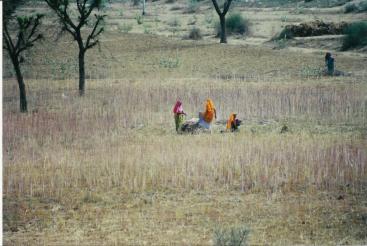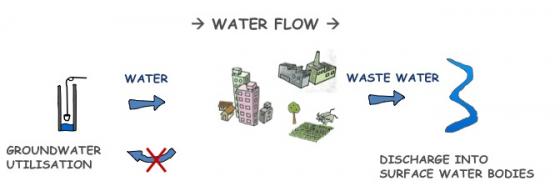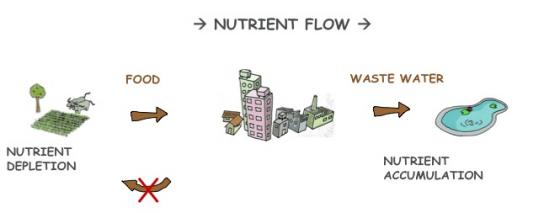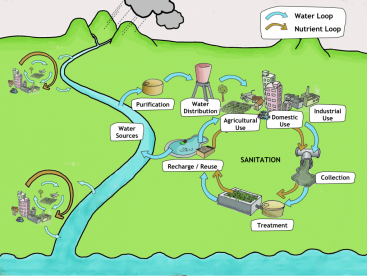Introduction
Water resources are under increasing pressure. Population growth, urbanisation and a steep increase in water consumption for domestic uses, agriculture and industry have significantly heightened water consumption. Climate change exacerbates the problem. This development leads to water scarcity and conflicts worldwide and seriously undermines progress towards achieving the Millennium Development Goals.

Will there be enough water and nutrients for small-scale farmers in the future? Source: CONRADIN (2007)
Changing consumption patterns such as an increased demand for meat and dairy products, monoculture or the production of biofuels also require more water, and furthermore also more nutrient inputs in agriculture. In particular in development countries, where artificial fertiliser is expensive (as it is bound to world market prices), the nutrients that are taken from the soil by harvesting crops are often not replaced. The area of degraded soil increases steadily - one quarter of the surface land of the earth are already degraded, putting the livelihoods of millions of people at risk (SCIENCE DAILY 2009). These problems are recognised, yet we do not recognise their interdependence. We now continue to deal with them in a sectoral manner:
Water & wastewater
- If there is not enough surface water, aquifers are tapped, also in areas where these aquifers are not recharged under current climatic conditions. The wastewater generate in such a way continues do be discharged in surface water, leading to decreasing water tables.
- Water is provided without taking into consideration wastewater management, leading to pollution of aquatic ecosystems.

Groundwater that is taken from aquifers and then discharged into surface waters leads to decreasing water tables, thus limiting water availability in the long term. Source: CONRADIN (2010)
Agriculture
Nutrients that are taken from the soil in the form or plants are consumed, excreted again and discharged with wastewater into watercourses. In the long term, if they are not replaced in agriculture, this leads to decreasing yields and soil degradation. To counteract this, artificial fertiliser is mined and applied — though artificial fertilisers are energy intensive and the availability of some of the constituent parts (e.g. phosphorus) are limited (see also the nutrient cycle).

There is a linear approach to how we manage nutrients at the moment: Often, they are taken from the soil, consumed, and then discharged with wastewater in aquatic ecosystems, where they cause severe problems. Source: CONRADIN (2010)
These sectoral approaches ignore one crucial fact: The water cycle and the nutrient cycle are inherently linked. When using water, be it for agriculture, for use in households or industries, water is contaminated and wastewater produced. Parts of this “contamination” are valuable plant nutrients. Wastewater is considered a waste, because of the many negative consequences it has on health and the environment it discharged in an uncontrolled manner into the environment. Yet: they need not be. Wastewater is not a waste: It is simply a misplaced resource. If we deal with it properly, it is a highly valuable resource!
Wastewater is a resource in the following ways:
- It contains a lot of nutrients that can be used in agriculture or aquaculture and can replace mineral fertilisers.
- Wastewater contains energy: This energy can be in the form of heat, which can be reused using heat exchangers, or in the form of biogas produced from wastewater (which can also be transformed to electricity).
- Wastewater contains water: After treatment, this water can be reused for many purposes such as irrigation, washing etc.

The SSWM Cycle. Source: SEECON (2010)
The benefits of wastewater can only be used if we consider agriculture, water management and sanitation together:
- Each local water cycle - here indicated with the blue arrows - is influenced by water uses upstream and again has impacts on water uses downstream. Each intervention in water management must consider these issues (see integrated water resources management).
- When water is used - for agriculture, industry or households - wastewater is produced. Different sanitation options treat it in such a way that the potentials of wastewater can be used. It is essential to recognise the potentials of this wastewater. Containing nutrients and water - both crucial resources for food production - it is essential to link water management with agriculture.
- This approach should be considered on a global level. Yet, its practical implementation starts at the local level: Farmers being aware of the benefits of wastewater and using it for fertigation, industries recycling their used waters, and families using rainwater for showering, or for watering their gardens. That is why this toolbox aims primarily at the local and practical implementation level.
Such an approach to water management — linking water management, sanitation, and agriculture — is a crucial step to sustainability:
- It closes water cycle at a local level, recharges groundwater sources and provides valuable water for agriculture.
- It closes nutrient cycle, thus making expensive artificial fertilisers unnecessary and provides a much more balanced fertiliser.
- It improves food security, and even creates additional income.
- It applies solutions that are socially acceptable, economically viable and environmentally sustainable (see also sustainable sanitation).
Sick Water? The central role of wastewater management in sustainable development
This book not only identifies the threats to human and ecological health that water pollution has and highlights the consequences of inaction, but also presents opportunities, where appropriate policy and management responses over the short and longer term can trigger employment, support livelihoods, boost public and ecosystem health and contribute to more intelligent water management.
CORCORAN, E. ; NELLEMANN, C. ; BAKER, E. ; BOS, R. ; OSBORN, D. ; SAVELLI, H. (2010): Sick Water? The central role of wastewater management in sustainable development. A Rapid Response Assessment. United Nations Environment Programme (UNEP), UN-HABITAT, GRID-Arendal URL [Accessed: 05.05.2010] PDFOne Quarter Of The World’s Population Depends On Degrading Land
SDG 6 along the water and nutrient cycles
This AGUASAN publication illustrates how the water and nutrient cycles can be used as a tool for creating a common understanding of a water and sanitation system and aligning it with SDG 6.
BROGAN, J., ERLMANN, T., MUELLER, K. and SOROKOVSKYI, V. (2017): SDG 6 along the water and nutrient cycles. Using the water and nutrient cycles as a tool for creating a common understanding of a water and sanitation system - including workshop material. Bern (Switzerland): AGUASAN and Swiss Agency for Development and Cooperation (SDC) URL [Accessed: 26.03.2019] PDFSick Water? The central role of wastewater management in sustainable development
This book not only identifies the threats to human and ecological health that water pollution has and highlights the consequences of inaction, but also presents opportunities, where appropriate policy and management responses over the short and longer term can trigger employment, support livelihoods, boost public and ecosystem health and contribute to more intelligent water management.
CORCORAN, E. ; NELLEMANN, C. ; BAKER, E. ; BOS, R. ; OSBORN, D. ; SAVELLI, H. (2010): Sick Water? The central role of wastewater management in sustainable development. A Rapid Response Assessment. United Nations Environment Programme (UNEP), UN-HABITAT, GRID-Arendal URL [Accessed: 05.05.2010] PDFSustainable Water and Waste-Water Management: Energy- and Material-Flow-Management - Quo vadis?
By taking the example of phosphorus, this essays shows that besides encompassing elaborate treatments to produce high quality water discharges to recipient bodies, the various substances brought into the water by human activities might also be extraordinarily valuable.
KIEFHABER, P. (2010): Sustainable Water and Waste-Water Management: Energy- and Material-Flow-Management - Quo vadis?. The Example 'Phosphorus-Recycling'. Kaiserslauten: Dr. Kiefhaber + zebe ingenieur consult gmbhSustainable Wastewater Management. A handbook for smaller communities
This handbook was written to guide small communities in New Zealand to adopt sustainable wastewater management practices. Those communities considering an alternative system to their existing one need guidance on the way to organise a scheme and the work required to deliver an appropriate solution. Such a solution needs to be acceptable to the authorities that protect our public health and environment and yet is affordable to the community. Sometimes the technology is conventional, and sometimes it needs to be less so in order to ensure its affordability. Sometimes all that is required is a little basic knowledge on the finance sources available for a community scheme.
MINISTRY OF ENVIRONMENT (2003): Sustainable Wastewater Management. A handbook for smaller communities. MNE: Wellington URL [Accessed: 24.08.2010]Looking up the pipe and down the drain!
This briefing note discusses the linkages between sanitation options and water resources and the ways in which concerns for both can be effectively integrated and managed.
SMITS, S. (2005): Looking up the pipe and down the drain! . Positioning sanitation within Integrated Water Resources Management. Leicestershire: WELL Resource Centre URL [Accessed: 31.10.2010]Pathways for Sustainable Sanitation
In line with the overall SuSanA objectives, this document should contribute to the work surrounding the MDGs by outlining a number of pathways, or stepping-stones, towards more sustainable practices in sanitation. It draws on the work of SuSanA’s thematic working groups and attempts to act as a bridge between the principles and theory of sustainable sanitation (Vision Document) and eventual recommendations for concrete action plans.
SUSANA (2011): Pathways for Sustainable Sanitation. (= SuSanA Factsheet ). Sustainable Sanitation Alliance (SuSanA) URL [Accessed: 01.02.2011]Integrated Water Resources Management
This paper provides analysis and explanation of the major challenges and trends in integrated water resources management (IWRM), successful examples of where practical approaches to IWRM generated good solutions to water and sanitation (WATSAN) problems, and also links to further sources of information, tools and approaches that can be used by WATSAN professionals in their work.
MORIARTY, P. BUTTERWORTH, J. BATCHELOR, C. (2004): Integrated Water Resources Management. And the domestic water and sanitation sub-sector. (= Tematic Overview Paper (TOP) ). Delft: International Water and Sanitation Centre (IRC) URL [Accessed: 07.11.2011]Ecodesign: The Bottom Line
There is no single design solution to sanitation. But there are universal principles for systematically and safely detoxifying human excreta, without contaminating, wasting or even using water. Ecological sanitation design — which is focused on sustainability through reuse and recycling — offers workable solutions that are gaining footholds around the world, as Nature explores on the following pages through the work of Peter Morgan in Zimbabwe, Ralf Otterpohl and his team in Germany, Shunmuga Paramasivan in India, and Ed Harrington and his colleagues in California.
NATURE (Editor) ; MORGAN, P. ; OTTERPOHL, R. ; PARAMASIVAN, S. ; HARRINGTON, E. (2012): Ecodesign: The Bottom Line. In: Nature: International Weekly Journal of Science: Volume 486 , 186-189. URL [Accessed: 19.06.2012]Peak Phosphorus
This article raises attention to the impacts of phosphorus as a finite resource on the fertiliser prices and its geopolitical implications. The author wants to raise public awareness to this problem and calls for policy reforms that aim at integrating the agricultural and sanitation sector.
Rosemarin, A. Bruijne, de G. Caldwell, I. (2009): Peak Phosphorus. The next inconvenient truth. Amsterdam: The Broker URL [Accessed: 18.03.2013]Peak Phosphorus and the Eutrophication of Surface Waters: A Symptom of Disconnected Agricultural and Sanitation Policies
This paper is discussing the limited mineral sources of phosphorus, their management in human systems, the respective flows and net losses and the need for increased efficiency and recycling. The paper explores the policy and technology disconnections between the practices in using phos¬phorus fertiliser in agriculture, the control of phosphorus in effluents, the management of the mineral reserves and products therein and the need for environment-friendly recycling systems.
Rosemarin, A. (2010): Peak Phosphorus and the Eutrophication of Surface Waters: A Symptom of Disconnected Agricultural and Sanitation Policies . In: On the Water Fron: Volume 2 URL [Accessed: 18.03.2013]Der Nexus Wasser-Energie-Nahrung
Vernetzte Versorgungsrisiken mit sektor- und grenzüberschreitenden Wechselwirkungen stellen für die Politik eine große Herausforderung dar. Ziel der vorliegenden Studie ist, die politische Dimension solcher Probleme zu erfassen und Bearbeitungsoptionen zu diskutieren. Denn häufig ist nicht die Verfügbarkeit einer Ressource oder der Mangel an Lösungsansätzen das zentrale Problem. Stattdessen fehlt es oft am politischen Willen, ein integriertes und langfristig nachhaltiges Management von Ressourcen und Risiken zielstrebig umzusetzen.
BEISHEIM, M (2013): Der Nexus Wasser-Energie-Nahrung. Wie mit vernetzten Versorgungsrisiken umgehen?. Berlin: Stiftung Wissenschaft und Politik (SWP) URL [Accessed: 07.10.2013]Language: German
Compilation of 27 Case Studies on Sustainable Sanitation Projects from Sub-Sahara Africa
The Sustainable Sanitation Alliance (SuSanA) publishes case studies of sustainable sanitation projects from around the world to demonstrate the wide range of available technologies for sustainable sanitation systems. This case study book only comprises those project examples which are from sub-Saharan African countries. These case studies are useful for decision makers, planners, researchers, engineers and the interested public. They have compiled descriptions of well-running projects as well as of less successful projects so that we can learn from past mistakes.
INGLE, R. MUENCH, E. von (2011): Compilation of 27 Case Studies on Sustainable Sanitation Projects from Sub-Sahara Africa. Eschborn: Sustainable Sanitation Alliance (SuSanA) URL [Accessed: 29.05.2012]Planning Tools
This Sustainable Sanitation Practice (SSP) issue contains the following contributions: 1. Better Design Planning Tools, 2. Tackling Complex Urban Sanitation Problems, 3. The SSWM Toolbox, 4. Comparing Economic Costs of Sanitation
MUELLEGGER, E. ; LANGEGRABER, G. ; LECHNER, M. (2011): Planning Tools. (= Sustainable Sanitation Practice , 7 ). Vienna: Ecosan Club URL [Accessed: 01.07.2013]Gee Whiz: Human urine is shown to be an effective agricultural fertilizer
The Scientific American is a popular science magazine in the US. This article, written for laymen, states that urine not only promotes plant growth as well as industrial mineral fertilizers, but also saves energy.
GRUNBAUM, M. (2010): Gee Whiz: Human urine is shown to be an effective agricultural fertilizer. In: Scientific American: Volume 30 URL [Accessed: 17.04.2012]Yellow is the new Green
This opinion contribution from Rose George published in the New York Times emphasises the enormous potential urine as a sustainable fertiliser source.
GEORGE, R. (2009): Yellow is the new Green. In: The New Your Times: , 27. URL [Accessed: 27.07.2010]Facts and Trends. Water (Version 2)
The brochure „Water: Facts and Trends“ by the WBCSD (World Business Council on Sustainable Development) offers a series of appealing graphics a well structured presentation of the main (but not detailed) facts and trends on water and the state of water resources today.
WBCSD (2009): Facts and Trends. Water (Version 2). Geneva: World Business Council for Sustainable Development (WBDSC) URL [Accessed: 20.04.2010]http://vimeo.com/
This video explains that artificial fertilizer is a resource as limited as oil, and that we all produce a fertilizer every day that could replace it: urine.
Water, Land and People: Voices and insights from three continents
The initiative “Water, Land and People: Voices and insights from three continents“ promoted by the Swiss Agency for Development and Cooperation (SDC) aims at sharing and deepening the knowledge base of SDC and partners in order to improve the development strategies and policies with regard to Integrated Water Resource Management (IWRM) with emphasis on the aspect Water for Food.
GWP IWRM ToolBox
The website of GWP contains the toolbox as a web-based learning tool itself and additionally all publications by GWP. Topics of IWRM, Good Water Governance and many more IWRM related issues are discussed in a very comprehensive way. A very extensive collection of high-quality papers are available in English, French, Spanish and Russian. The site also contains a very extensive collection of case studies
http://www.youtube.com
This weblink contains a short animated video introducing closed loop concepts: Sanimation. This is how the makers advertise Sanimation: The truth about the last taboo of our age. The reason for why you should give a shit.

